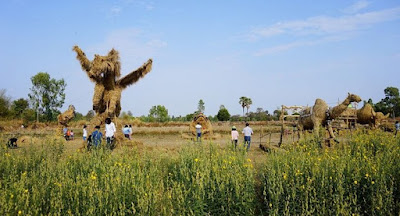The villages of Maha Sarakham have no problem charming visitors
WITH ARCHAIC moats and stone boundary
markers indicating where the settlement of Champa Sri was located 1,000
years ago, the small Maha Sarakham town of Na Dun is sitting on a rich
vein of history.
Culture and religion flourished here atop Thailand’s vast northeastern
plateau during the Dvaravati Period. Nowadays, they seem to be enjoying a
revival.
Downtown Maha Sarakham is 45 minutes away by car. Na Dun welcomes
visitors – many of them pilgrims – with the Phra That Na Dun, a shrine
built in 1985 to house revered relics of the Lord Buddha. They were
moved here from the original bronze stupa that was unearthed in 1979.
.
.
On the morning we arrived, a nine-day temple fair was just beginning.
About 5,000 residents were performing traditional Isaan dances of
homage at the shrine. There was a colourful procession along the
one-kilometre main road lined with food stalls and little shops selling
handcrafts and other merchandise.
After participating in a heart-cleansing ritual, we headed to a nearby
hamlet, Ban Nong No Tai, where a troupe of dek thevada was a treating
folks to a striking mor lam hun performance at a communal theatre.
Artist Preecha Karoon got the dancing going in 2008 with the support of
the Thai Health Promotion Foundation. They bring in skilled mor lam and
shadow-play enthusiasts to teach the youngsters how it’s done. They’re
having fun as they help preserve traditions unique to the Northeast.
..
.
“I worked at the Patravadi Theatre for two years, and for this some
young talented people and I created our own puppets – they’re adapted
from second-hand kratib,” says Preecha, referring to bamboo containers
containing sticky rice.
“The performers’ costumes are made from old wrap-skirts and the theatre
itself was built with money we made performing in other locales. We also
had the help of university lecturers in setting up home-stays and
making souvenir hun kratib to sell. Most of all we’re all very grateful
to Grandma Somsri Phadeechan, who donated the land.”
The story the troupe depicts draws on local legends and Buddhist lore.
In anywhere from 10 minute to an hour, depending on the telling, they
illustrate the lives of Sang Sin Chai and Angulimala, with three artists
controlling each puppet figure.
“We have 32 members who can be split up into three groups based on age,”
Preecha says. “We spent three months rehearsing. It’s a new approach,
with mor lam artists singing and playing the khene [mouth organ] as they
recount the story.”
.


